The Thermodynamics of Selenium Minerals in Near-Surface Environments
Abstract
:1. Introduction
2. Materials and Methods
2.1. Mineral Systems of Selenium Minerals
2.2. Thermodynamics
3. Results and Discussion
3.1. Thermodynamic System Co–Se–H2O
3.2. Thermodynamic System Ni–Se–H2O
3.3. Thermodynamic System Fe–Se–H2O
3.4. Thermodynamic System Cu–Se–H2O
3.5. Thermodynamic System Pb–Se–H2O
3.6. Thermodynamic System Zn–Se–H2O
3.7. Thermodynamic System Cd–Se–H2O
3.8. Thermodynamic System Hg–Se–H2O
3.9. Thermodynamic System Ag–Se–H2O
3.10. Thermodynamic System Bi–Se–H2O
3.11. Thermodynamic System As–Se–H2O
3.12. Thermodynamic System Sb–Se–H2O
3.13. Thermodynamic System Al–Se–H2O
3.14. Thermodynamic System Ca–Se–H2O
3.15. Selenates
3.16. Thermodynamic Data
4. Conclusions
Supplementary Materials
Acknowledgments
Author Contributions
Conflicts of Interest
References
- Khamkhash, A.; Srivastava, V.; Ghosh, T.; Akdogan, G.; Ganguli, R.; Aggarwal, S. Mining-Related Selenium Contamination in Alaska, and the State of Current Knowledge. Minerals 2017, 7, 46. [Google Scholar] [CrossRef]
- Lemly, A.D. Aquatic selenium pollution is a global environmental safety issue. Ecotoxicol. Environ. Saf. 2004, 59, 44–56. [Google Scholar] [CrossRef]
- Sandy, T.; DiSante, C. Review of Available Technologies for the Removal of Selenium from Water; Technical Report; CH2M Hill: Englewood, CO, USA, June 2010; pp. 2–223. [Google Scholar]
- Plant, J.A.; Bone, J.; Voulvoulis, N.; Kinniburgh, D.G.; Smedley, P.L.; Fordyce, F.M.; Klinck, B. Arsenic and selenium. In Environmental Geochemistry; Treatise on Geochemistry; Holland, H.D., Turekain, K.K., Eds.; Elsevier: Oxford, UK, 2014; Volume 11, pp. 13–57. [Google Scholar]
- Sharma, V.K.; McDonald, T.J.; Sohn, M.; Anquandah, G.A.K.; Pettine, M.; Zboril, R. Biogeochemistry of selenium: A review. Environ. Chem. Lett. 2014, 13, 49–58. [Google Scholar] [CrossRef]
- Séby, F.; Potin-Gautier, M.; Giffaut, E.; Donard, O.F.X. Assessing the speciation and the biogeochemical processes affecting the mobility of selenium from a geological repository of radioactive wastes to the biosphere. Analysis 1998, 26, 193–198. [Google Scholar] [CrossRef]
- Chen, F.; Burns, P.C.; Ewing, R.C. 79Se: Geochemical and crystallo-chemical retardation mechanisms. J. Nucl. Mater. 1999, 275, 81–94. [Google Scholar] [CrossRef]
- Charykova, M.V.; Krivovichev, V.G. Mineral systems and the thermodynamics of selenites and selenates in the oxidation zone of sulfide ores—A review. Mineral. Petrol. 2017, 111, 121–134. [Google Scholar] [CrossRef]
- Krivovichev, V.G.; Charykova, M.V. Classification of Mineral Systems; St.-Petersburg University Press: Saint-Petersburg, Russia, 2013; 196p. (In Russian) [Google Scholar]
- Krivovichev, V.G.; Charykova, M.V. Number of minerals of various chemical elements: Statistics 2012 (a new approach to an old problem). Geol. Ore Depos. 2014, 56, 553–559. [Google Scholar] [CrossRef]
- Hawthorne, F.C. The use of end-member charge-arrangements in defining new mineral species and heterovalent substitutions in complex minerals. Can. Mineral. 2002, 40, 699–710. [Google Scholar] [CrossRef]
- Hatert, F.; Burke, E.A.J. The IMA-CNMNC dominant-constituent rule revised and extended. Can. Mineral. 2008, 46, 717–728. [Google Scholar]
- Christy, A.G. Causes of anomalous mineralogical diversity in the Periodic Table. Mineral. Mag. 2015, 79, 33–49. [Google Scholar]
- Nickel, E.H. The definition of a mineral. Can. Mineral. 1995, 33, 689–690. [Google Scholar]
- Nickel, E.H.; Grice, J.D. The IMA Commission on New Minerals and Mineral Names: Procedures and guidelines on mineral nomenclature. Can. Mineral. 1998, 36, 913–926. [Google Scholar]
- Mills, S.J.; Hatert, F.; Nickel, E.H.; Ferraris, G. The standardisation of mineral group hierarchies: Application to recent nomenclature proposals. Eur. J. Mineral. 2009, 21, 1073–1080. [Google Scholar] [CrossRef]
- Charykova, M.V.; Lelet, M.I.; Krivovichev, V.G.; Ivanova, N.M.; Suleimanov, E.V. A calorimetric and thermodynamic investigation of the synthetic analogue of chalcomenite, CuSeO3∙2H2O. Eur. J. Mineral. 2017, 29, 269–277. [Google Scholar] [CrossRef]
- Lelet, M.I.; Charykova, M.V.; Krivovichev, V.G.; Efimenko, N.M.; Platonova, N.V.; Suleimanov, E.V. A Calorimetric and Thermodynamic Investigation of Zinc and Cadmium Hydrous Selenites. J. Chem. Thermodyn. 2017, 115, 63–73. [Google Scholar] [CrossRef]
- Boone, S.; Kleppa, O.J. Enthalpies of formation for group IV selenides (GeSe2, GeSe2(am), SnSe, SnSe2, PbSe) by directcombination drop calorimetry. Thermochim. Acta 1992, 197, 109–121. [Google Scholar] [CrossRef]
- Gattow, G.; Schneider, A. Die Bildungsenthalpien im System Kupfer-Selen. Z. Anorg. Allg. Chem. 1956, 286, 296–306. (In German) [Google Scholar] [CrossRef]
- Grønvold, F. High-temperature reaction calorimeter. Enthalpy of formation of iron selenides and nickel selenides at 1050 K. Acta Chem. Scand. 1972, 26, 2085–2099. [Google Scholar] [CrossRef]
- Grønvold, F.; Westrum, E.F., Jr. Heat capacities and thermodynamic functions of iron disulphide (pyrite), iron diselenide, and nickel diselenide from 5 to 350 K. The estimation of standard entropies of transition metal chalcogenides. Inorg. Chem. 1962, 1, 36–48. [Google Scholar] [CrossRef]
- Leshchinskaya, Z.L.; Selivanova, N.M. Thermodynamic properties of calcium selenite. Tr. Inst.-Mosk. Khim.-Tekhnol. Inst. Im. D.I. Mendeleeva. 1963, 44, 37–40. (In Russian) [Google Scholar]
- Leshchinskaya, Z.L.; Selivanova, N.M. Thermodynamic properties of copper selenites. Zh. Fiz. Khim. 1965, 39, 2430–2434. (In Russian) [Google Scholar]
- Leshchinskaya, Z.L.; Selivanova, N.M.; Maier, A.I.; Strel’tsov, I.S.; Muzalev, E.Y. Heat of formation of nickel and cobalt selenites. Zh. Vses. Khim. O-va Im. D. I. Mendeleeva. 1963, 8, 577–578. (In Russian) [Google Scholar]
- Maekawa, T.; Yokokawa, T.; Niwa, K. Enthalpies of mixing in the liquid state. IV. Bi + Se and Sb + Se. J. Chem. Thermodyn. 1972, 4, 873–878. [Google Scholar] [CrossRef]
- Nasar, A.; Shamsuddin, M. Thermodynamic properties of zinc selenide. Z. Metallkd 1990, 81, 244–246. [Google Scholar]
- O’Hare, P.A.G.; Lewis, B.M.; Susman, S.; Volin, K.J. Standard molar enthalpies of formation and transition at the temperature 298.15 K and other thermodynamic properties of the crystalline and vitreous forms of arsenic sesquiselenide (As2Se3). Dissociation enthalpies of As-Se bonds. J. Chem. Thermodyn. 1990, 22, 1191–1206. [Google Scholar] [CrossRef]
- Petrova, Z.K.; Kofman, N.A. Heat capacity and some thermodynamic properties of cadmium selenide. Dokl. Akad. Nauk BSSR 1976, 20, 688–690. (In Russian) [Google Scholar]
- Selivanova, N.M.; Leshchinskaya, Z.L.; Klushina, T.V. Physicochemical properties of selenites. I. Thermodynamic properties of silver selenite. Zh. Phiz. Khim. 1962, 36, 1349–1352. (In Russian) [Google Scholar]
- Selivanova, N.M.; Leshchinskaya, Z.L. Physical-chemical properties of selenites. Thermodynamic properties of lead selenite. Tr. Inst.-Mosk. Khim.-Tekhnol. Inst. Im. D. I. Mendeleeva. 1962, 38, 37–42. (In Russian) [Google Scholar]
- Selivanova, N.M.; Leshchinskaya, Z.L.; Maier, A.I.; Strel’tsov, I.S.; Muzalev, E.Y. Thermodynamic properties of nickel selenite dehydrate. Zh. Fiz. Khim. 1963, 37, 1563–1567. (In Russian) [Google Scholar]
- Sirota, N.N.; Petrova, Z.K.; Solovoskii, T.D. Heat capacity of zinc selenide in the 4,2–300 K region. Dokl. Akad. Nauk BSSR 1980, 24, 214–217. (In Russian) [Google Scholar]
- Stolyarova, T.A.; Gavrilov, N.M.; Nekrasov, I.Y. Thermodynamic properties of bismuth selenides. Geokhimiya 1990, 9, 1367–1374. (In Russian) [Google Scholar]
- Chukhlantsev, V.G.; Tomashevsky, G.P. The solubility of the selenites of certain metals. Zh. Anal. Khim. 1957, 12, 296–302. (In Russian) [Google Scholar]
- Chukhlantsev, V.G. Solubility product of selenite of some metals. Zh. Neorg. Khim. 1956, 1, 2300–2305. (In Russian) [Google Scholar]
- Gospodinov, G.; Barkov, D. Das System HgO-SeO2-H2O bei 25 und 100 °C. Z. Phys. Chem. (Munich) 1991, 171, 241–247. (In German) [Google Scholar] [CrossRef]
- Slavtscheva, J.; Popova, E.; Gospodinov, G. Untersuchung von Löslichkeit und Löslichkeitsprodukt bei Seleniten der Elemente der IV. Gruppe des Periodensystems. Z. Chem. 1984, 24, 105–106. (In German) [Google Scholar] [CrossRef]
- Slavtscheva, J.; Popova, E.; Gospodinov, G. Untersuchung der Löslichkeit und Bestimmung des Löslichkeitsproduktes von Kupfer-und Silberselenit. Monatsh. Chem. 1993, 124, 1115–1118. (In German) [Google Scholar] [CrossRef]
- Popova, E.; Slavtscheva, J.; Gospodinov, G. Untersuchung der Löslichkeit einiger Phasen des Systems M2O3-SeO2-H2O der Elemente der 3. Gruppe des Periodensystems der Elemente. Z. Chem. 1986, 26, 342–343. (In German) [Google Scholar] [CrossRef]
- Rai, D.; Felmy, A.R.; Moore, D.A. The solubility product of crystalline ferric selenite hexahydrate and the complexation constant of FeSeO3+. J. Solution Chem. 1995, 24, 735–752. [Google Scholar] [CrossRef]
- Ripan, R.; Vericeanu, G. Conductimetric determination of the solubility product of some selenites. Stud. Univ. Babes-Bolyai Chem. 1968, 13, 31–37. (In Romanian) [Google Scholar]
- Mehra, M.C.; Gubeli, A.O. The complexing characteristics of insoluble selenides. 1. Silver selenide. Can. J. Chem. 1970, 48, 3491–3497. [Google Scholar] [CrossRef]
- Savenko, V.S. Solubility product of magnesium and calcium selenites. Zh. Neorg. Khim. 1995, 40, 1254–1256. (In Russian) [Google Scholar]
- Séby, F.; Potin-Cautier, M.; Giffaut, E.; Borge, G.; Donard, O.F.X. A critical review of thermodynamic data for selenium species at 25 °C. Chem. Geol. 2001, 171, 173–194. [Google Scholar] [CrossRef]
- Olin, A.; Nolang, B.; Osadchii, E.G.; Ohman, L.-O.; Rosen, E. Chemical Thermodynamics of Selenium; Elsevier: Amsterdam, The Netherlands, 2005; 851p. [Google Scholar]
- Wagman, D.D.; Evans, W.H.; Parker, V.B.; Schumm, R.H.; Halow, I.; Bailey, S.M.; Churney, K.L.; Nuttall, R.L. The NBS tables of chemical thermodynamic properties: Selected values for inorganic and C1 and C2 organic substances in (SI) units. J. Phys. Chem. Ref. Data 1982, 11 (Suppl. 2), 1–392. [Google Scholar]
- Charykova, M.V.; Krivovichev, V.G.; Depmeier, W. Thermodynamics of arsenates, selenites and sulphates in oxidising zone of sulphides ore deposits. Part I: Thermodynamic properties at standard conditions. Geol. Ore Depos. 2010, 52, 759–770. [Google Scholar] [CrossRef]
- Charykova, M.V.; Krivovichev, V.G.; Lelet, M.I.; Yakovenko, O.S.; Suleimanov, E.V.; Depmeier, W.; Semenova, V.V.; Zorina, M.L. A calorimetric and thermodynamic investigation of the synthetic analogues of cobaltomenite, CoSeO3∙2H2O, and ahlfeldite, NiSeO3∙2H2O. Am. Mineral. 2014, 99, 742–748. [Google Scholar] [CrossRef]
- Bethke, C.M.; Yeakel, S. The Geochemist’s Workbench (Release 9.0); LLC: Champaign, IL, USA, 2011; 130p. [Google Scholar]
- Krivovichev, V.G.; Charykova, M.V.; Yakovenko, O.S.; Depmeier, W. Thermodynamics of Arsenates, Selenites, and Sulfates in the Oxidation Zone of Sulfide Ores. IV. Eh–pH Diagrams of the Me–Se–H2O Systems (Me = Co, Ni, Fe, Cu, Zn, Pb) at 25 °C. Geol. Ore Depos. 2011, 53, 514–527. [Google Scholar] [CrossRef]
- Charykova, M.V.; Krivovichev, V.G.; Yakovenko, O.S.; Semenova, V.V.; Semenov, K.N.; Depmeier, W. Thermodynamics of Arsenates, Selenites, and Sulfates in the Oxidation Zone of Sulfide Ores. VI. Solubility of Synthetic Analogs of Ahlfeldite and Cobaltomenite at 25 °C. Geol. Ore Depos. 2012, 54, 638–646. [Google Scholar] [CrossRef]
- Charykova, M.V.; Fokina, E.L.; Krivovichev, V.G.; Yakovenko, O.S.; Klimova, E.V.; Semenova, V.V. Thermodynamics of Arsenates, Selenites, and Sulfates in the Oxidation Zone of Sulfide Ores. X. Thermal Stability and Dehydration Features of Synthetic Analogs of the Cobaltomenite–Ahlfeldite Solid Solution Series. Geol. Ore Depos. 2015, 57, 570–578. [Google Scholar] [CrossRef]
- Fokina, E.L.; Klimova, E.V.; Charykova, M.V.; Krivovichev, V.G.; Platonova, N.V.; Semenova, V.V.; Depmeier, W. Thermodynamics of Arsenates, Selenites, and Sulfates in the Oxidation Zone of Sulfide Ores. VIII. Field of Thermal Stability of Synthetic Analog of Chalcomenite, its Dehydration and Dissociation. Geol. Ore Depos. 2014, 56, 538–545. [Google Scholar] [CrossRef]
- Charykova, M.V.; Krivovichev, V.G.; Ivanova, N.M.; Semenova, V.V. Thermodynamics of Arsenates, Selenites, and Sulfates in the Oxidation Zone of Sulfide Ores. XI. Solubility of Synthetic Chalcomenite Analog and Zinc Selenite at 25 °C. Geol. Ore Depos. 2015, 57, 691–698. [Google Scholar] [CrossRef]
- Pekov, I.V.; Zubkova, N.V.; Yapaskurt, V.O.; Britvin, S.N.; Chukanov, N.V.; Lykova, I.S.; Sidorov, E.G.; Pushcharovsky, D.Y. Zincomenite, ZnSeO3, a new mineral from the Tolbachik volcano, Kamchatka, Russia. Eur. J. Mineral. 2016, 28, 997–1004. [Google Scholar] [CrossRef]
- Charykova, M.V.; Fokina, E.L.; Klimova, E.V.; Krivovichev, V.G.; Semenova, V.V. Thermodynamics of Arsenates, Selenites, and Sulfates in the Oxidation Zone of Sulfide Ores. IX. Physico-chemical Formation Conditions and Thermal Stability of Zinc Selenites. Geol. Ore Depos. 2014, 56, 546–552. [Google Scholar] [CrossRef]
- Bur’yanova, E.Z.; Kovalev, G.A.; Komkov, A.I. The new mineral cadmoselite. Zap. Vsesojuz. Miner. Obshch. 1957, 86, 626–628. (In Russian) [Google Scholar]
- Naumann, C.F. XI. Classe. Galenoide oder Glanze. B. Selenische Glanze. 531. Selenmercur oder Tiemannit. In Elemente der Mineralogie; Wilhelm Engelmann: Leipzig, Germany, 1855; p. 425. (In German) [Google Scholar]
- Haidinger, W. Zweite Klasse: Geogenide. XIV. Ordnung. Glanze. III. Silberglanz. Naumannit. In Handbuch der Bestimmenden Mineralogie; Braumüller and Seidel: Vienna, Austria, 1845; pp. 563–570. (In German) [Google Scholar]
- Dunn, P.J.; Peacor, D.R.; Criddle, A.J.; Finkelman, R.B. Laphamite, an arsenic selenide analogue of 557 orpiment, from burning anthracite deposits in Pennsylvania. Mineral. Mag. 1986, 50, 279–282. [Google Scholar] [CrossRef]
- Chen, L.; Zhang, Q.; Li, D.; Wang, G. Antimonselite, a new mineral. Acta Mineral. Sin. 1993, 13, 7–11, (In Chinese with English abstract). [Google Scholar]
- Kampf, A.R.; Mills, S.J.; Nash, B.P.; Thorne, B.; Favreau, G. Alfredopetrovite: A new selenite mineral from the El Dragόn mine. Eur. J. Mineral. 2016, 28, 479–484. [Google Scholar] [CrossRef]
- Kasatkin, A.V.; Plášil, J.; Marty, J.; Agakhanov, A.A.; Belakovskiy, D.I.; Lykova, I.S. Nestolaite, CaSeO3·H2O, a new mineral from the Little Eva mine, Grand County, Utah, USA. Mineral. Mag. 2014, 78, 497–505. [Google Scholar] [CrossRef]
- Charykova, M.V.; Krivovichev, V.G. Thermodynamics of environmentally important natural and synthetic phases containing selenium. In Biogenic-Abiogenic Interactions in Natural and Anthropogenic Systems; Springer-Verlag: Heidelberg, Germany, 2016; pp. 145–155. [Google Scholar]
- Krivovichev, V.G.; Depmeier, W. Selenates and selenites: Systems Se-S-H2O, Pb-Se-S-H2O, U-Se-H2O and U-Se-I-H2O—Thermodynamical analysis and geological applications. Zap. Ross. Mineral. Obshch. 2005, 134, 1–14. (In Russian) [Google Scholar]
- Mandarino, J.A. Natural and synthetic selenites and selenates and their Gladstone-Dale compatibility. Eur. J. Mineral. 1994, 6, 337–349. [Google Scholar] [CrossRef]
- Burke, E.A.J. A Mass Discreditation of GQN Minerals. Can Mineral. 2007, 44, 1557–1560. [Google Scholar] [CrossRef]
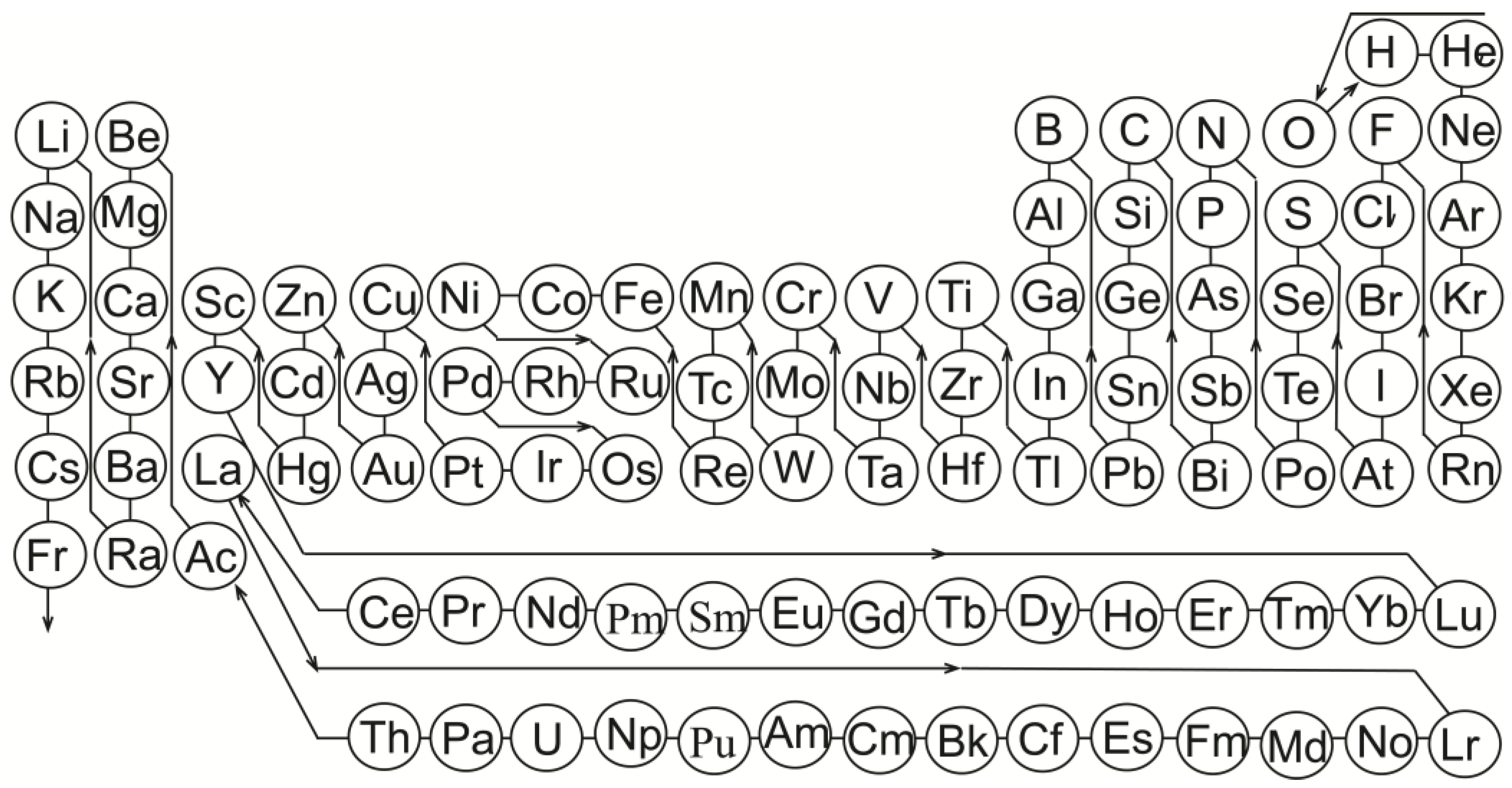
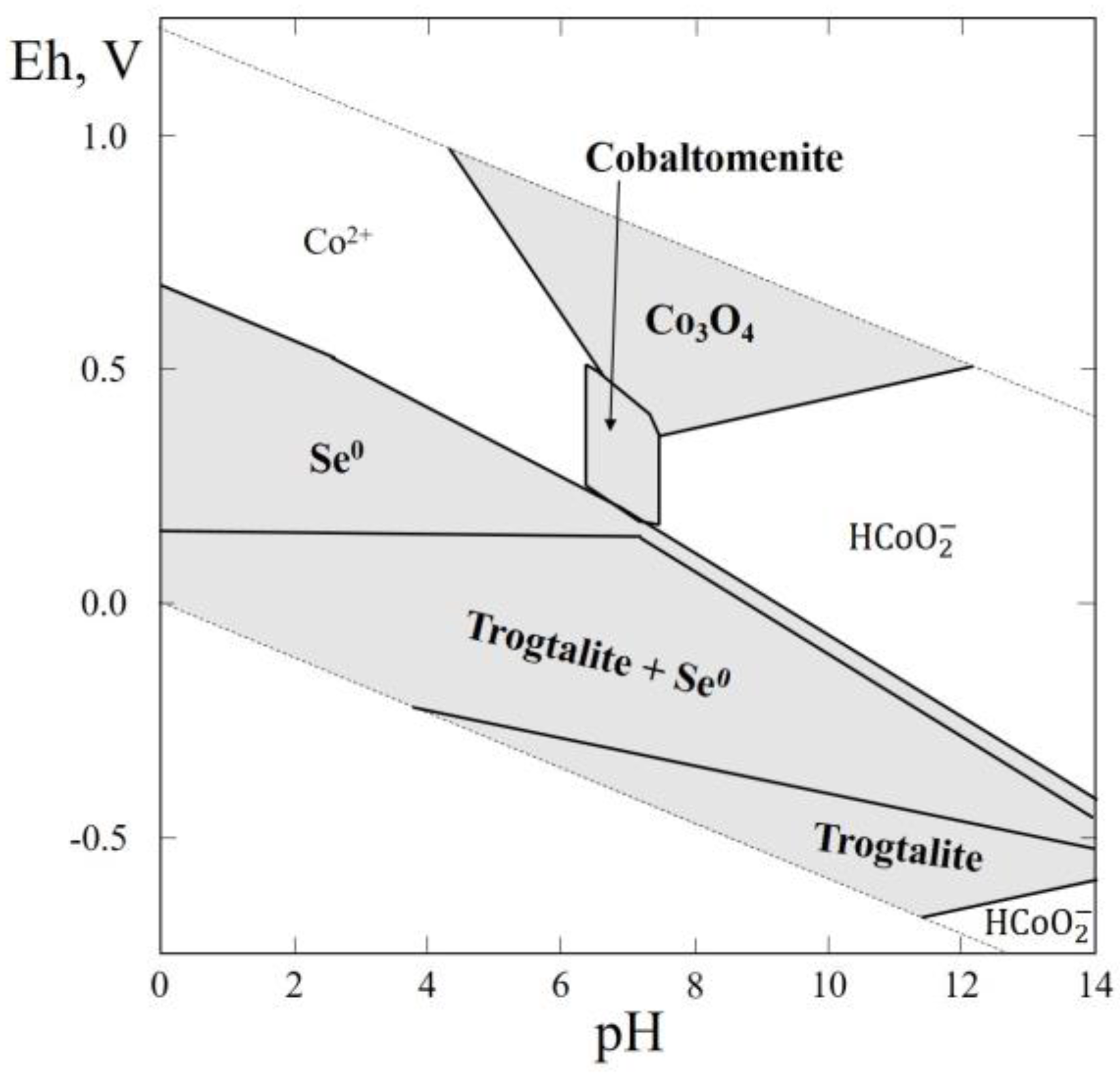
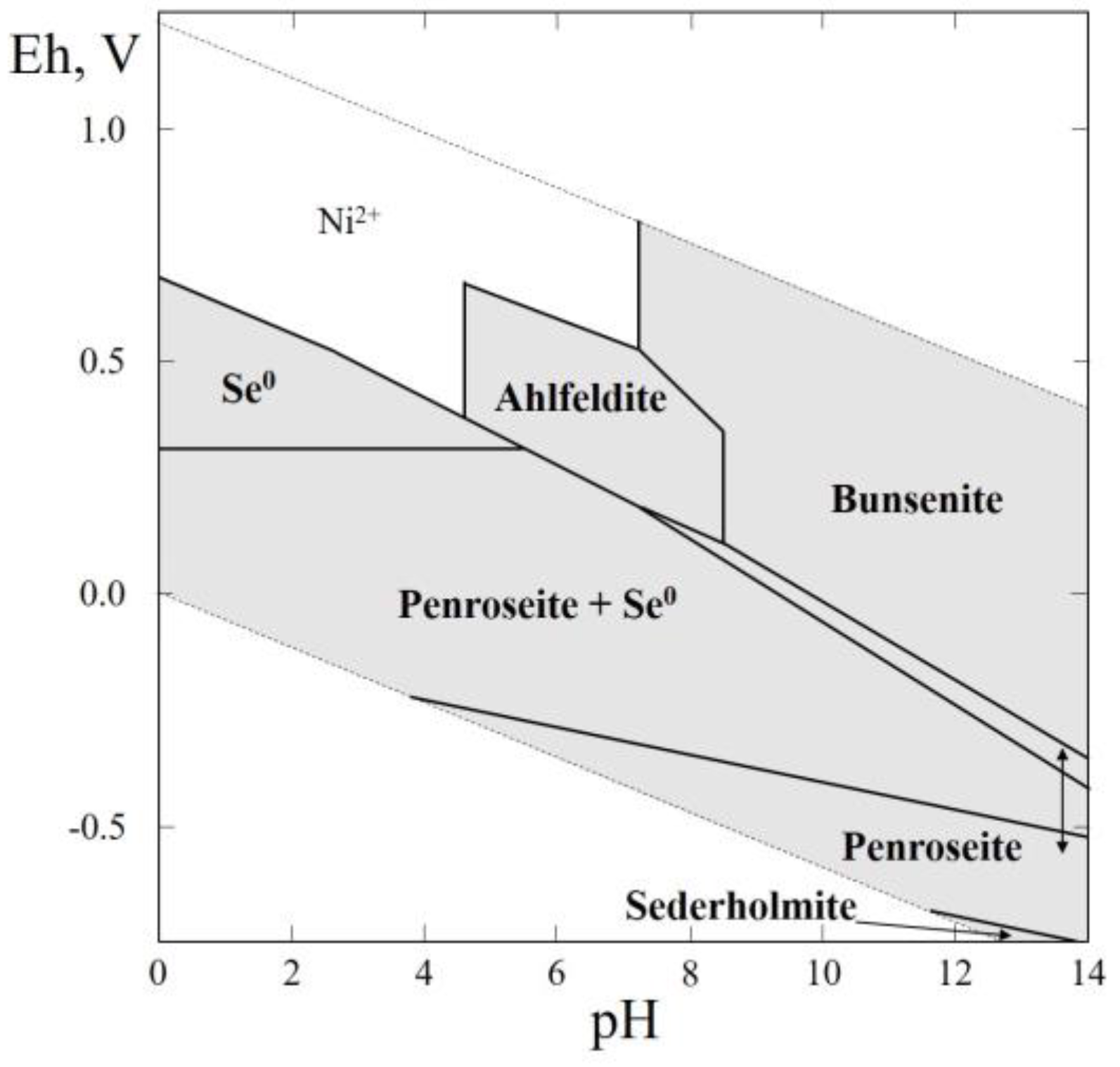
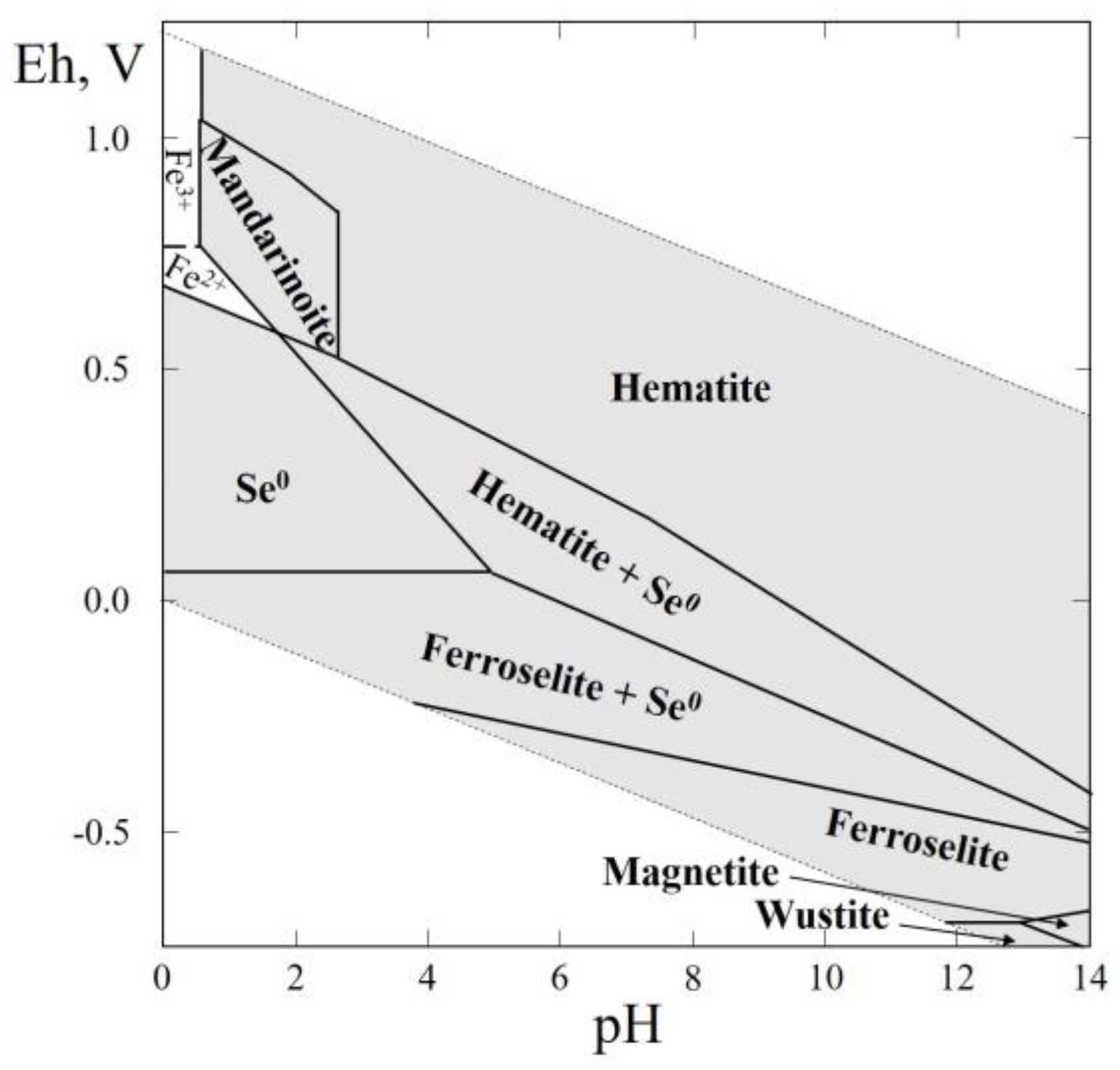
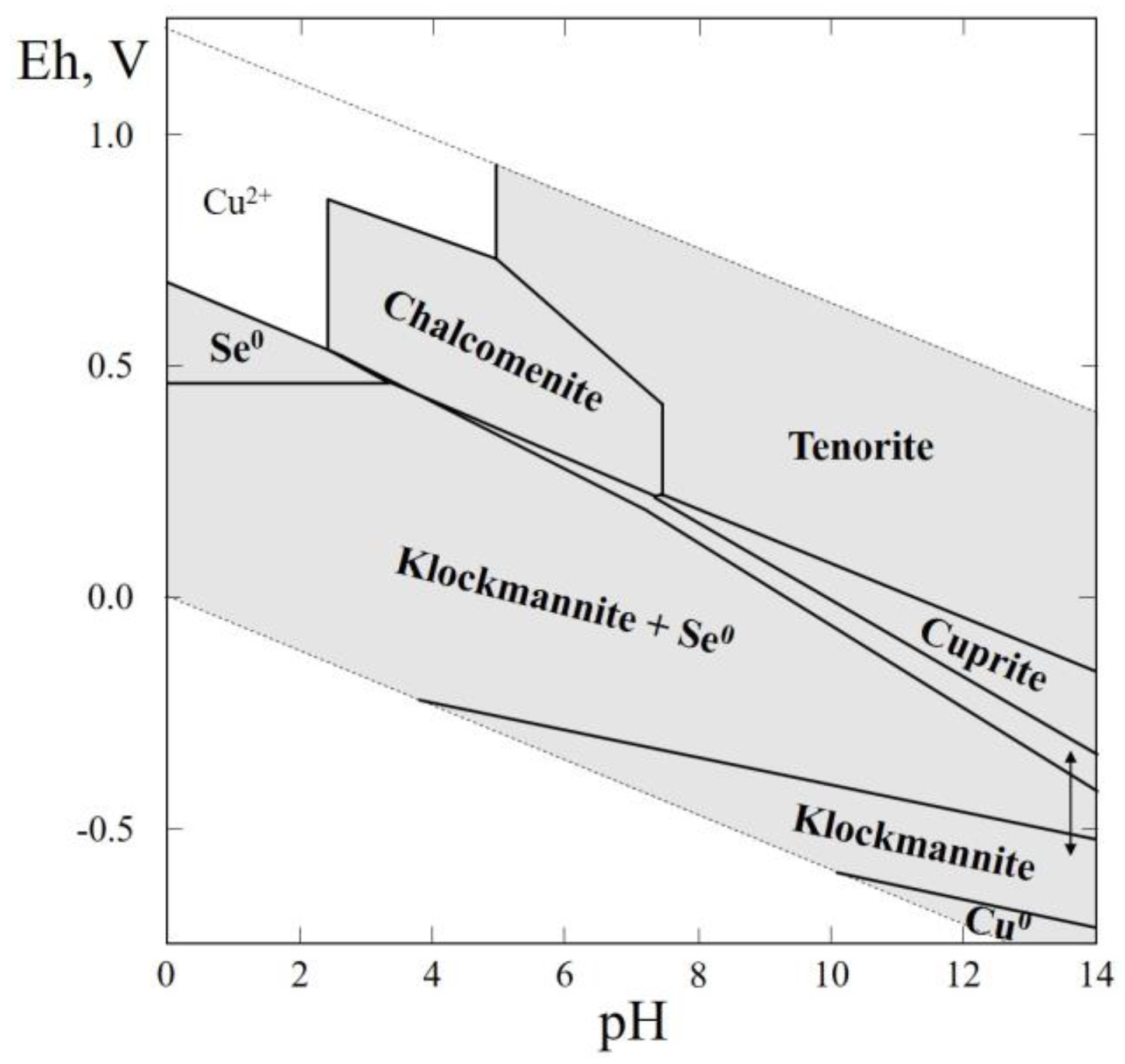
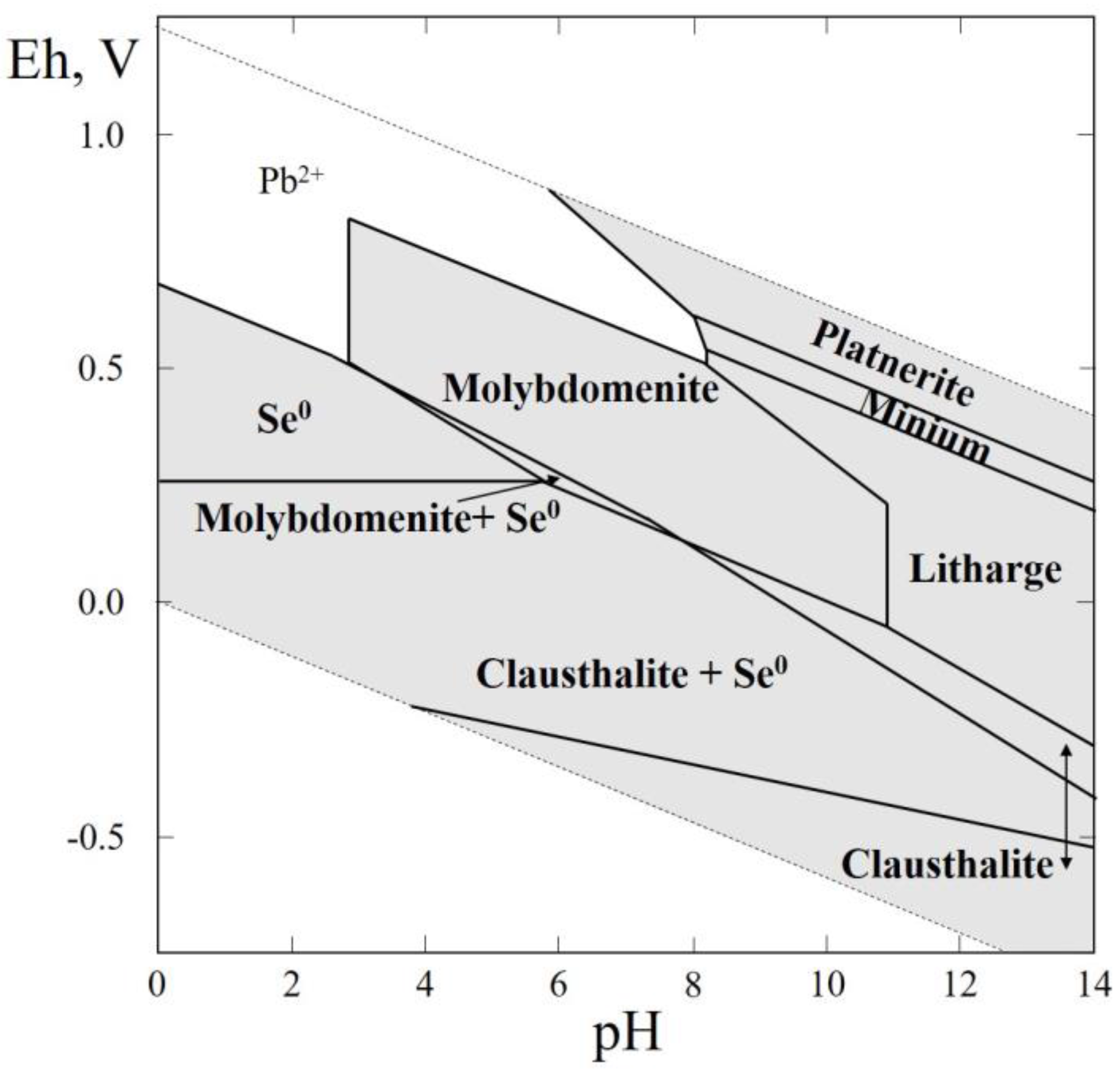
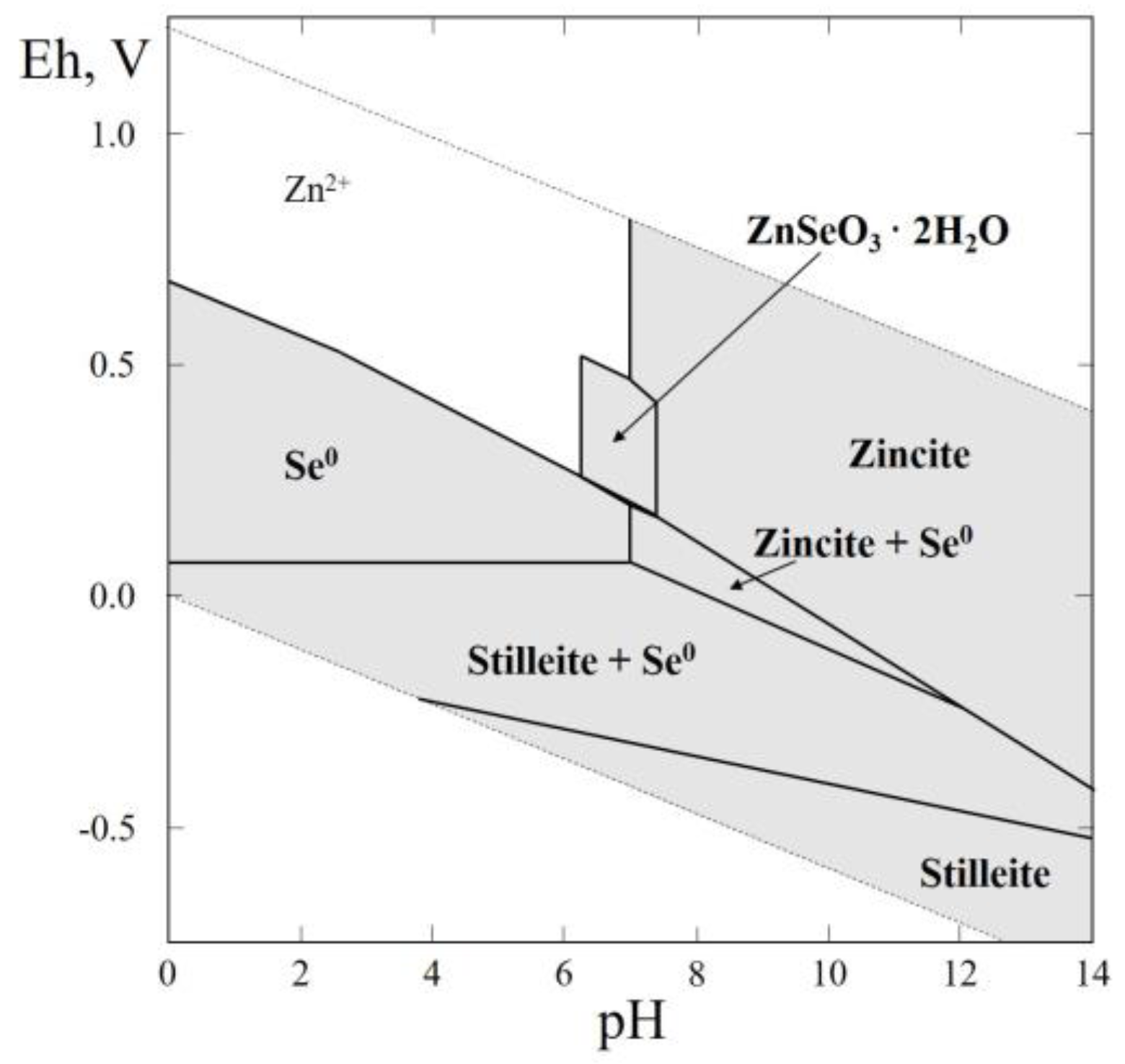
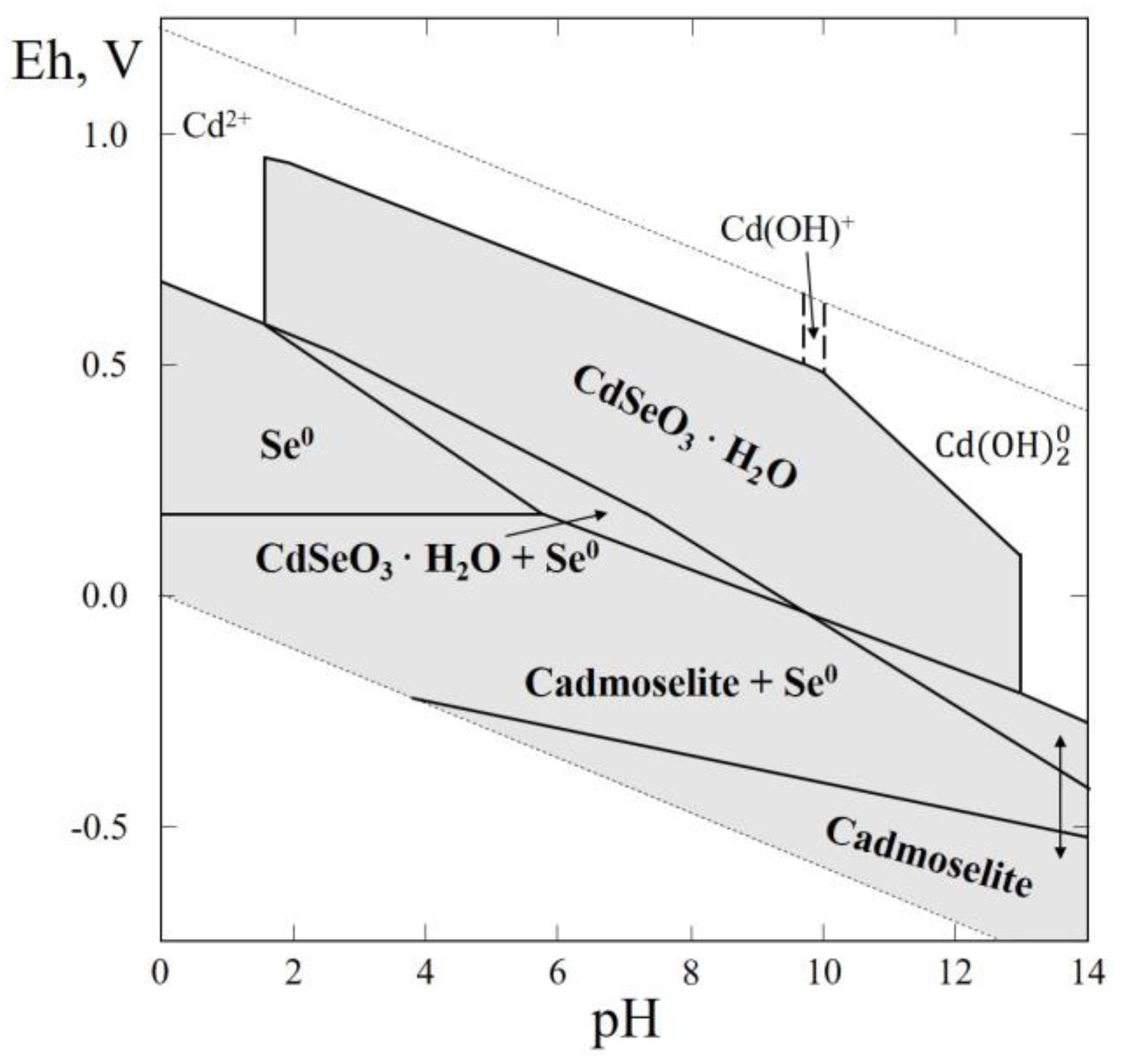
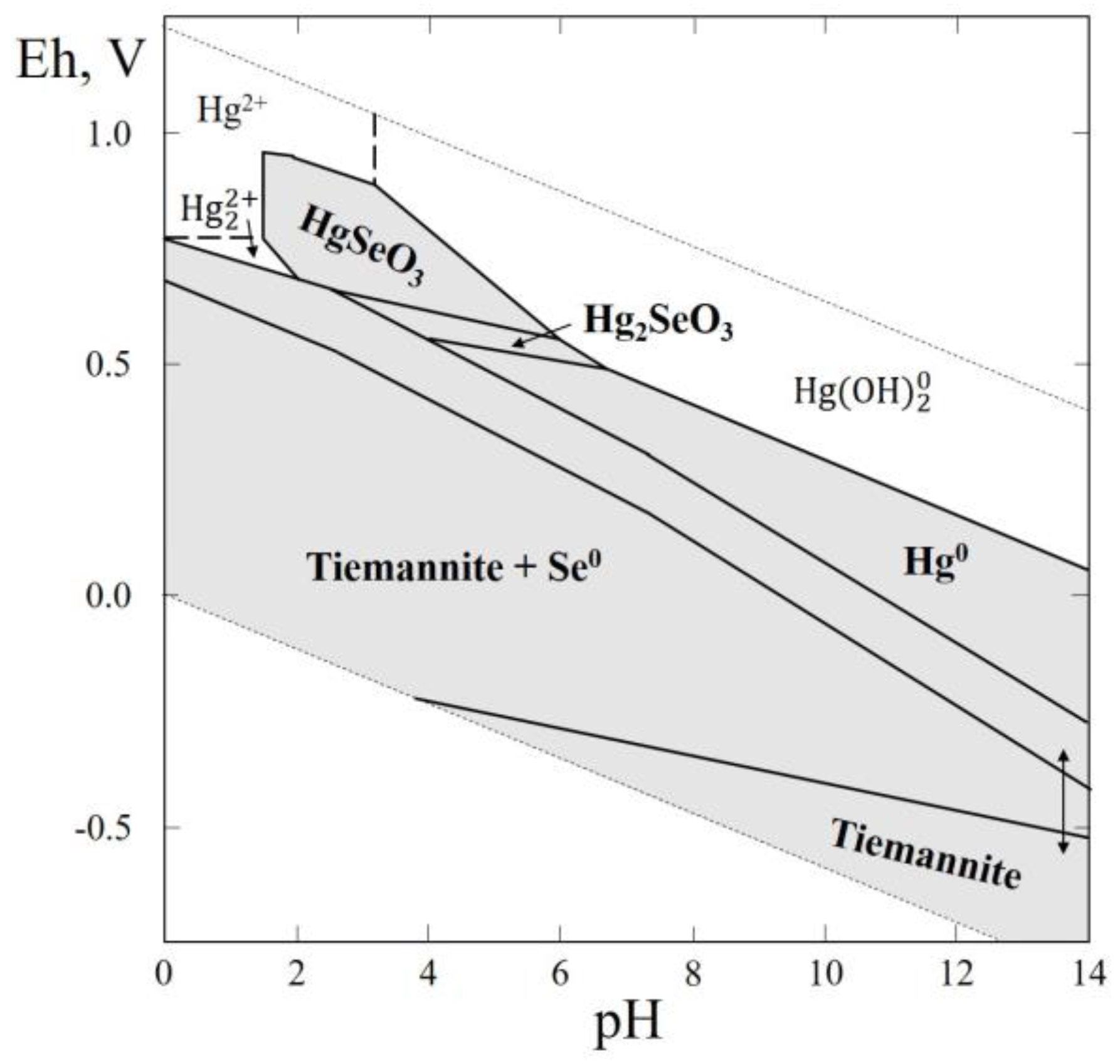
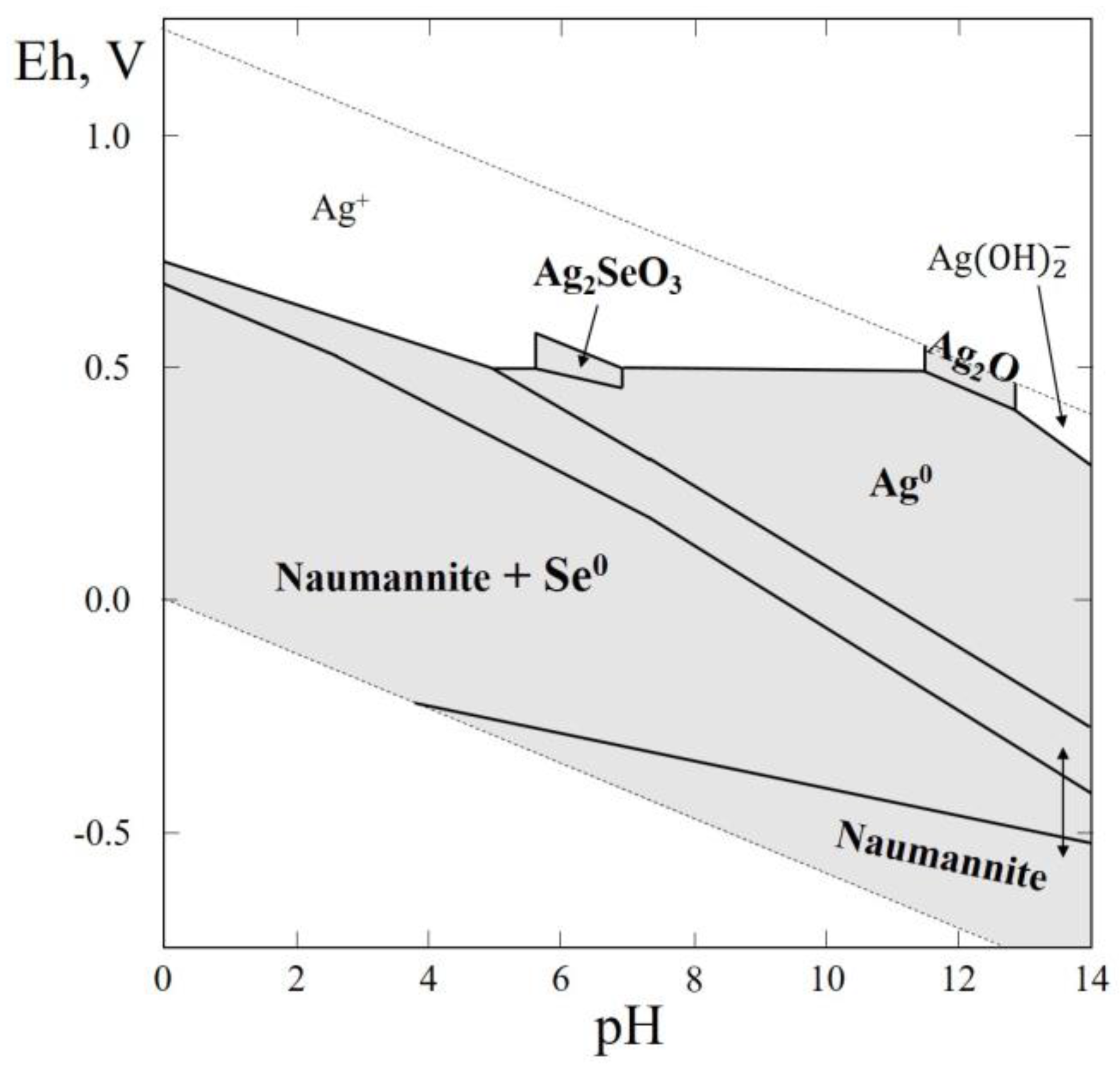
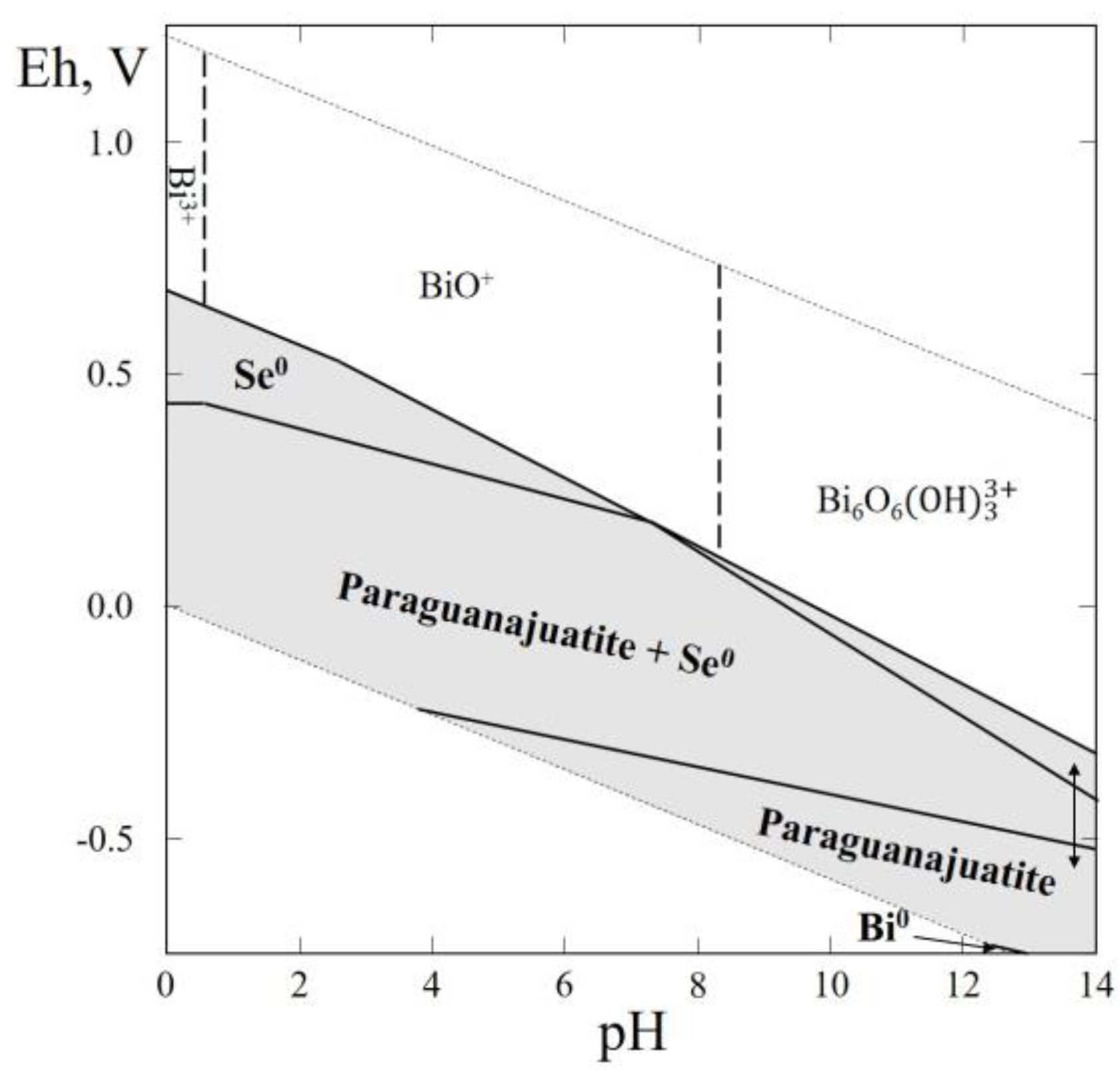
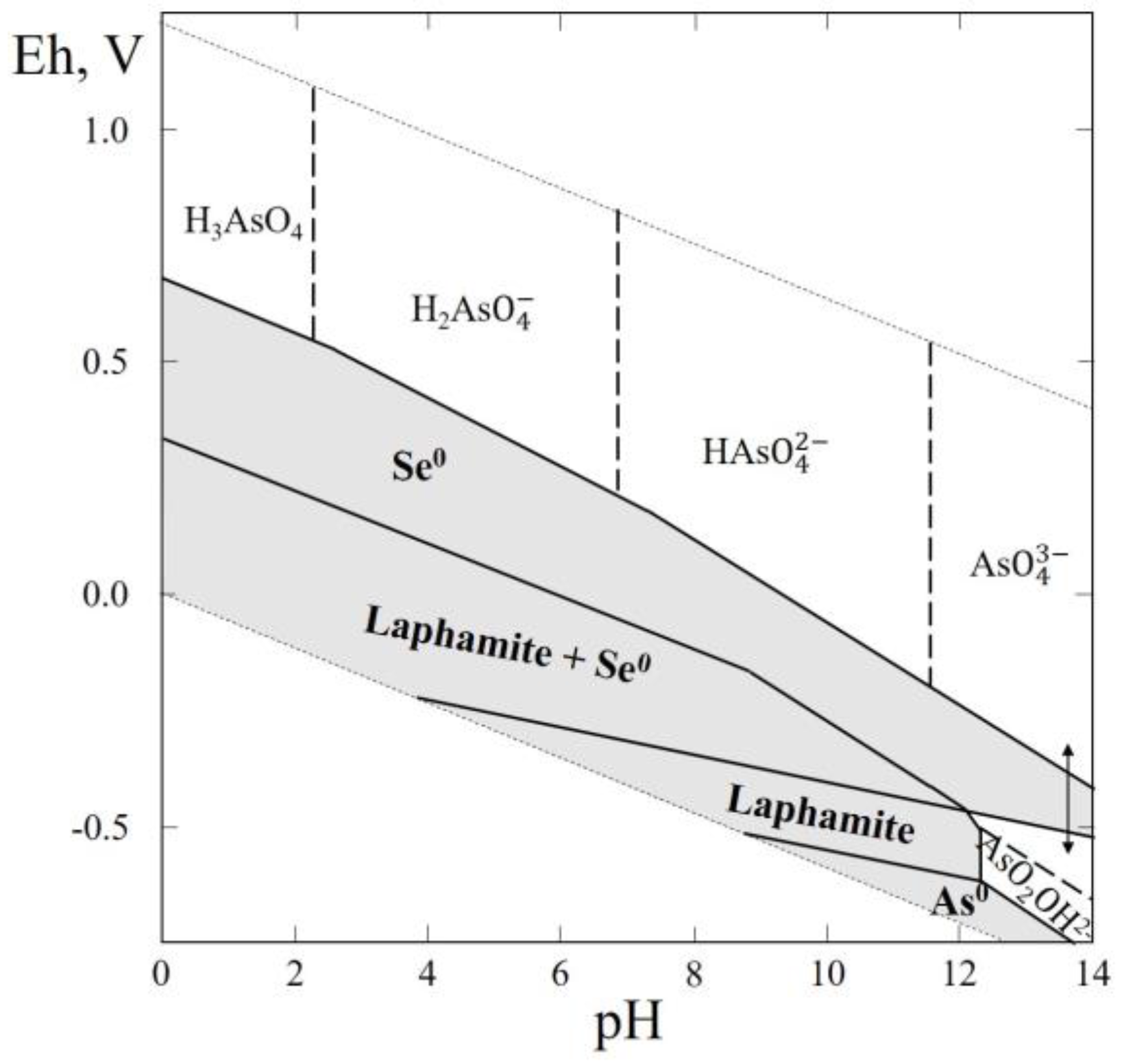

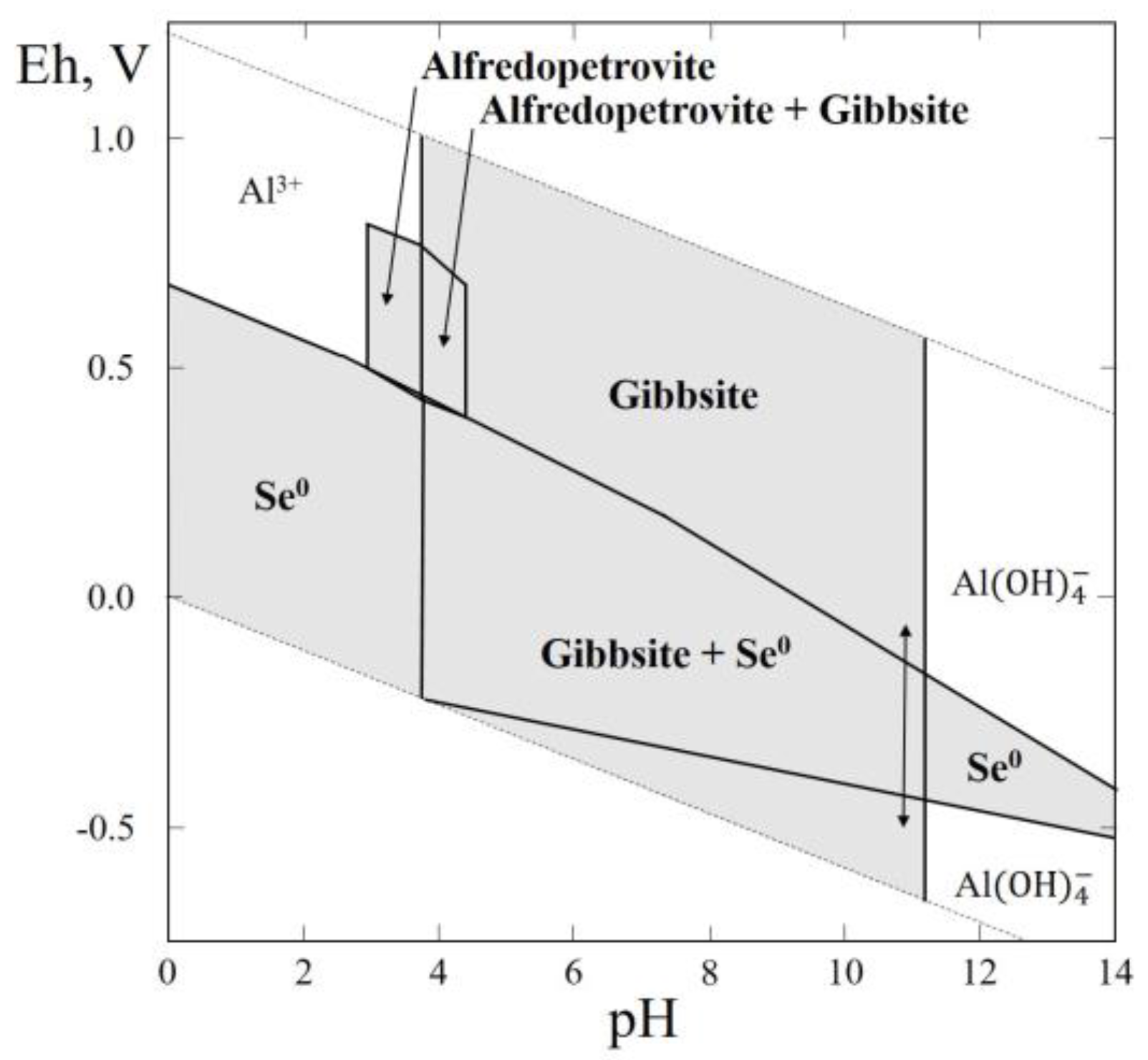

| n | System | Mineral | Chemical Formula | ΔfG0298, kJ/mol |
|---|---|---|---|---|
| Native Elements | ||||
| 1 | Se | Selenium | Se | 0 |
| Oxides | ||||
| 2 | OSe | Downeyite | SeO2 | −171.80 ± 0.62 |
| Selenides | ||||
| 2 | SeAs | Laphamite | As2Se3 | −83.9 ± 4.2 |
| SeSb | Antimonselite | Sb2Se3 | −127.4 ± 3.7 | |
| SeBi | Nevskite | BiSe | −46.8 ± 5.7 | |
| Guanajuatite | Bi2Se3 | −146.6 ± 10.1 | ||
| Paraguanajuatite | Bi2Se3 | – | ||
| Laitakarite | Bi4Se3 | – | ||
| SePb | Clausthalite | PbSe | −97.9 ± 7.7 | |
| SeMo | Drysdallite | MoSe2 | – | |
| SeFe | Achávalite | FeSe | −70.1 ± 4.0 | |
| Dzharkenite (cub) | FeSe2 | – | ||
| Ferroselite (orth) | FeSe2 | −101.3 ± 15.0 | ||
| SeCo | Bornhardtite | CoCo2Se4 | – | |
| Freboldite | CoSe | −56.3 ± 6.5 | ||
| Trogtalite | CoSe2 | −100.4 ± 15.0 | ||
| SeNi | Sederholmite | NiSe | −69.8 ± 1.6 | |
| Mäkinenite | NiSe | – | ||
| Penroseite | NiSe2 | −112.4 ± 7.0 | ||
| Kullerudite | NiSe2 | – | ||
| Trüstedtite | NiNi2Se4 | – | ||
| Wilkmanite | Ni3Se4 | – | ||
| SePd | Verbeekite | PdSe2 | – | |
| Oosterboschite | Pd7Se5 | – | ||
| Palladseite | Pd17Se15 | – | ||
| SePt | Sudovikovite | PtSe2 | – | |
| Luberoite | Pt5Se4 | – | ||
| SeCu | Klockmannite | CuSe | −36.8 ± 0.6 | |
| Krut’aite | CuSe2 | – | ||
| Petříčekite | CuSe2 | – | ||
| Bambollaite | CuSe2 | – | ||
| Bellidoite | Cu2Se | – | ||
| Berzelianite | Cu2Se | – | ||
| Umangite | Cu3Se2 | – | ||
| Athabascaite | Cu5Se4 | |||
| Geffroyite | Cu9Se8 | – | ||
| SeAg | Naumannite | Ag2Se | −46.9 ± 1.3 | |
| SeZn | Stilleite | ZnSe | −172.5 ± 4.0 | |
| SeCd | Cadmoselite | CdSe | −140.9 ± 1.9 | |
| SeHg | Tiemannite | HgSe | −51.2 ± 4.0 | |
| 3 | SSeAg | Aguilarite | Ag4SeS | – |
| SeTeBi | Kawazulite | Bi2Te2Se | – | |
| Skippenite | Bi2Se2Te | – | ||
| Telluronevskite | Bi3TeSe2 | – | ||
| Vihorlatite | Bi24Se17Te4 | – | ||
| SeTeNi | Kitkaite | NiTeSe | – | |
| SeTePd | Miessiite | Pd11Te2Se2 | – | |
| SeTeAg | Kurilite | Ag8Te3Se | – | |
| SeAsNi | Jolliffeite | NiAsSe | – | |
| SeAsPd | Kalungaite | PdAsSe | – | |
| SeAsCu | Mgriite | Cu3AsSe3 | – | |
| SeSbPd | Milotaite | PdSbSe | – | |
| SeSbCu | Bytízite | Cu3SbSe3 | – | |
| Permingeatite | Cu3SbSe4 | – | ||
| Příbramite | CuSbSe2 | – | ||
| SeSbAg | Selenostephanite | Ag5(SbSe3)Se | – | |
| SeBiPb | Poubaite | PbBi2Se4 | – | |
| SeBiPd | Padmaite | PdBiSe | – | |
| SeBiCu | Grundmannite | CuBiSe2 | – | |
| Hansblockite | CuBiSe2 | – | ||
| Eldragónite | Cu6BiSe4(Se2) | – | ||
| SeBiAg | Bohdanowiczite | AgBiSe2 | – | |
| SePbCu | Schlemaite | Cu6PbSe4 | – | |
| SeTlCu | Bukovite | Cu4Tl2Se4 | – | |
| Sabatierite | Cu6TlSe4 | – | ||
| Crookesite | Cu7TlSe4 | – | ||
| SeFeCu | Eskebornite | CuFeSe2 | – | |
| SeCoCu | Tyrrellite | CuCo2Se4 | – | |
| SePdCu | Jagüéite | Cu2Pd3Se4 | – | |
| SePdAg | Chrisstanleyite | Ag2Pd3Se4 | – | |
| SePdHg | Tischendorfite | Hg3Pd8Se9 | – | |
| SePtHg | Jacutingaite | Pt2HgSe3 | – | |
| SeCuAg | Eucairite | CuAgSe | – | |
| Selenojalpaite | Ag3CuSe2 | – | ||
| SeCuHg | Brodtkorbite | Cu2HgSe2 | – | |
| SeAgAu | Fischesserite | AgAuSe2 | – | |
| 4 | SeAsFeCu | Chaméanite | (Cu3Fe)Σ4AsSe4 | – |
| SeSbCuHg | Hakite | Cu6Cu4Hg2(SbSe3)4Se | – | |
| SeBiPbCu | Watkinsonite | Cu2PbBi4Se8 | – | |
| SeBiPbAg | Litochlebite | Ag2PbBi4Se8 | – | |
| 5 | SSeAsZnCu | Giraudite | Cu6Cu4Zn2(AsSe3)4S | – |
| SSeSbCuAg | Selenopolybasite | CuAg6Ag9Sb2S9Se2 | – | |
| SeBiPbCuHg | Petrovicite | Cu3HgPbBiSe5 | – | |
| Quijarroite | Cu6HgPb2Bi4Se12 | – | ||
| I. Selenites without H2O | ||||
| 3 | OSePb | Molybdomenite | PbSeO3 | −458.0 ± 6.0 |
| Plumboselite | Pb3(SeO3)O2 | – | ||
| 4 | OSeZn | Zincomenite | ZnSeO3 | – |
| OSSePb | Olsacherite | Pb2(SeO4)(SO4) | – | |
| OClSeCu | Georgbokiite | Cu5(SeO3)2O2Cl2 | – | |
| Parageorgbokiite | Cu5(SeO3)2O2Cl2 | – | ||
| Nicksobolevite | Cu7(SeO3)2O2Cl6 | – | ||
| Chloromenite | Cu9(SeO3)4O2Cl6 | – | ||
| OClSeZn | Sofiite | Zn2(SeO3)Cl2 | – | |
| 5 | OClSeBiCu | Francisite | Cu3Bi(SeO3)2O2Cl | – |
| OClSePbCu | Sarrabusite | Pb5Cu(SeO3)4Cl4 | – | |
| Allochalcoselite | CuCu5PbO2(SeO3)2Cl5 | – | ||
| OClSeCuNa | Ilinskite | NaCu5(SeO3)2O2Cl3 | – | |
| 6 | OClSeCdCuK | Burnsite | KCdCu7(SeO3)2O2Cl9 | – |
| 7 | OClSePbZnCuK | Prewittite | K2Pb3Zn2Cu12(SeO3)4O4Cl20 | – |
| II. Selenites and Selenates Containing H2O | ||||
| 4 | OHSeAl | Alfredopetrovite | Al2(SeO3)3·6H2O | −3657.4 |
| OHSeCo | Cobaltomenite | CoSeO3·2H2O | −937.4 ± 2.5 1 | |
| OHSeFe | Mandarinoite | Fe2(SeО3)3·6H2O | −2756.80 ± 7.3 | |
| OHSeNi | Ahlfeldite | NiSeO3⋅2H2O | −932.4 ± 2.5 1 | |
| OHSeCu | Chalcomenite | CuSeO3⋅2Н2О | −835.3 ± 5.3 2 | |
| OHSeU | Haynesite | (UO2)3(SeO3)2(OH)2⋅5H2O | – | |
| OHSeCa | Nestolaite | CaSeO3·H2O | −1188.9 ± 2.5 | |
| 5 | OHClSePb | Orlandiite | Pb3(SeO3)Cl4⋅H2O | – |
| OHSSeCu | Pauladamsite | Cu4(SeO3)(SO4)(OH)4·2H2O | – | |
| OHSePbCu | Schmiederite | Pb2Cu2(SeO3)(SeO4)(OH)4 | – | |
| OHSeCuU | Derriksite | Cu4(UO2)(SeO3)2(OH)6·H2O | – | |
| Marthozite | Cu(UO2)3(SeO3)2O2·8H2O | – | ||
| OHSeUCa | Piretite | Ca(UO2)3(SeO3)2(OH)4⋅4H2O | – | |
| OHSeUBa | Guilleminite | Ba(UO2)3(SeO3)2(OH)4·3H2O | – | |
| OHSeUNa | Larisaite | Na(H3O)(UO2)3(SeO3)2O2⋅4H2O | – | |
| 6 | OHSSePbCu | Munakataite | Pb2Cu2(SeO3)(SO4)(OH)4 | – |
| OHSeBiPbCu | Favreauite | PbBiCu6O4(SeO3)4(OH)·H2O | – | |
| OHSePbCuU | Demesmaekerite | Pb2Cu5(UO2)2(SeO3)6(OH)6⋅2H2O | – | |
| 7 | OHISeMgNaK | Carlosruizite | K6Na4Na6Mg10(SeO4)12(IO3)12·12H2O | – |
© 2017 by the authors. Licensee MDPI, Basel, Switzerland. This article is an open access article distributed under the terms and conditions of the Creative Commons Attribution (CC BY) license (http://creativecommons.org/licenses/by/4.0/).
Share and Cite
Krivovichev, V.; Charykova, M.; Vishnevsky, A. The Thermodynamics of Selenium Minerals in Near-Surface Environments. Minerals 2017, 7, 188. https://doi.org/10.3390/min7100188
Krivovichev V, Charykova M, Vishnevsky A. The Thermodynamics of Selenium Minerals in Near-Surface Environments. Minerals. 2017; 7(10):188. https://doi.org/10.3390/min7100188
Chicago/Turabian StyleKrivovichev, Vladimir, Marina Charykova, and Andrey Vishnevsky. 2017. "The Thermodynamics of Selenium Minerals in Near-Surface Environments" Minerals 7, no. 10: 188. https://doi.org/10.3390/min7100188





